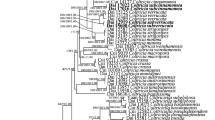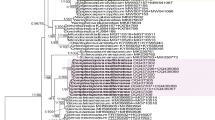Abstract
Previous studies have shown that Gloeophyllum s.l. is polyphyletic. We analyzed the combined ITS and nLSU rDNA sequences of most Gloeophyllum s.l. species and other taxa of Gloeophyllales retrieved from open databases. The Gloeophyllum s.s. clade included G. sepiarium, G. abietinum, G. striatum, and G. trabeum. Gloeophyllum imponens that is characterized by a strigose upper surface of basidiocarps and distinctly daedaleoid to lamellate hymenophore formed a single clade, and thus a new genus Hispidaedalea is erected to accommodate it. The genera Griseoporia and Osmoporus are supported. The new species Griseoporia taiwanense is described and illustrated, and the new combination Osmoporus mexicanus is proposed. An identification key to the four genera of Gloeophyllum s.l. is provided.



Similar content being viewed by others
References
Bondartsev AS (1959) O sistemticheskom polozhenii nekotorykh trutovykh gribov (On taxonomy of some polypores). Bot J USSR 44:447–456
Chenna R, Sugawara H, Koike T, Lopez R, Gibson TJ, Higgins DG, Thompson JD (2003) Multiple sequence alignment with the Clustal series of programs. Nucleic Acids Res 31:3497–3500. doi:10.1093/nar/gkg500
Corner EJH (1987) Ad Polyporaceas IV. Nova Hedwigia Heft 86:1–265
Dai YC (2010) Hymenochaetaceae (Basidiomycota) in China. Fungal Divers 45:131–343. doi:10.1007/s13225-010-0066-9
Dai YC (2012) Polypore diversity in China with an annotated checklist of Chinese polypores. Mycoscience 53:49–80. doi:10.1007/s10267-011-0134-3
Felsenstein J (1985) Confidence intervals on phylogenetics: an approach using bootstrap. Evolution 39:783–791. doi:10.2307/2408678
Garcia-Sandoval R, Wang Z, Binder M, Hibbett DS (2011) Molecular phylogenetics of the Gloeophyllales and relative ages of clades of Agaricomycotina producing a brown rot. Mycologia 103:510–524. doi:10.3852/10-209
Gilbertson RL, Ryvarden L (1986) North American polypores 1. Abortiporus – Lindtneria. Fungiflora, Oslo
Ginns J (1984) Griseoporia a new genus for Hexagonia carbonaria (Polyporaceae). Mycotaxon 20:559–565
Hall TA (1999) Bioedit: a user-friendly biological sequence alignment editor and analysis program for Windows 95/98/NT. Nucleic Acids Symp Ser 41:95–98
He SH, Li HJ (2013) Veluticeps microspora sp. nov. and V. ambigua new to Asia with a preliminary phylogenetic study on the genus. Mycol Prog 12:367–374. doi:10.1007/s11557-012-0842-x
Hibbet DS, Donoghue MJ (1995) Progress toward a phylogenetic classification of the Polyporaceae through parsimony analyses of ribosomal sequences. Can J Bot 73(S1):S853–S861. doi:10.1139/b95-331
Hibbet DS, Binder M, Bischoff JF et al (2007) A higher level phylogenetic classification of the Fungi. Mycol Res 111:509–547. doi:10.1016/j.mycres.2007.03.004
Hibbett DS, Binder M (2002) Evolution of complex fruiting body morphologies in homobasidiomycetes. Proc Biol Sci 269:1963–1969. doi:10.1098/rspb.2002.2123
Kim SY, Jung HS (2000) Phylogenetic relationships of the Aphyllophorales inferred from sequence analysis of nuclear small subunit ribosomal DNA. J Microbiol 38:122–131
Nylander JAA (2004) MrModeltest 2.2. Program distributed by the author. Evolutionary Biology Centre, Uppsala University, Uppsala
Page RMD (1996) Treeview: an application to display phylogenetic trees on personal computers. Comput Appl Biosci 12:357–358
Petersen JH (1996) Farvekort. The Danish Mycological Society’s colour-chart. Foreningen til Svampekundskabens Fremme, Greve
Ronquist F, Huelsenbeck JP (2003) MRBAYES 3: Bayesian phylogenetic inference under mixed models. Bioinformatics 19:1572–1574. doi:10.1093/bioinformatics/btg180
Ryvarden L (1977) Type studies in the Polyporaceae 10. Species described by J.M. Berkeley, either alone or with other authors, from 1844 to 1855. Norw J Bot 24:213–230
Ryvarden L (1991) Genera of polypores. Nomenclature and taxonomy. Syn Fungorum 5:1–363
Ryvarden L, Gilbertson RL (1993) European polypores 1, Abortiporus—Lindtneria. Syn Fungorum 6:1–387
Singer R (1944) Notes on taxonomy and nomenclature of the polypores. Mycologia 36:65–69. doi:10.2307/3754880
Swofford DL (2002) PAUP*: Phylogenetic analysis using parsimony (*and other methods). Version 4.0b10. Sinauer Associates, Sunderland
Teng SC (1990) Fungi of China. Ithaca, New York
Yuan HS, Dai YC, Wei YL (2004) Gloeophyllum (Basidiomycota, Aphyllophorales) in China. Mycosystema 23:173–176
Acknowledgments
We are grateful to Dr. Ping Du (Heilongjiang Agricultural Economy Vocational College, China) for assistance in molecular experiments, and to Dr. Hai-Jiao Li (Beijing Forestry University, China) for drawing the microscopic illustration. We thank Dr. Zheng Wang (Ecology and Evolutionary Biology Department, Yale University) for critical reading of the manuscript. Special thanks are due to Profs. Leif Ryvarden and Karl-Henrik Larsson (O, Norway), Dr. Pertti Salo (H, Finland) for loans of specimens. This study was supported by the National Natural Science Foundation of China (Project No. 31070022) and institutional support RVO (Project No. 60077344) to J. Vlasák.
Author information
Authors and Affiliations
Corresponding author
Rights and permissions
About this article
Cite this article
He, SH., Vlasák, J. & Dai, YC. Hispidaedalea gen. nov. and Griseoporia taiwanense sp. nov. (Gloeophyllales, Basidiomycota) based on morphological and molecular characters. Mycol Progress 13, 833–839 (2014). https://doi.org/10.1007/s11557-014-0966-2
Received:
Revised:
Accepted:
Published:
Issue Date:
DOI: https://doi.org/10.1007/s11557-014-0966-2




